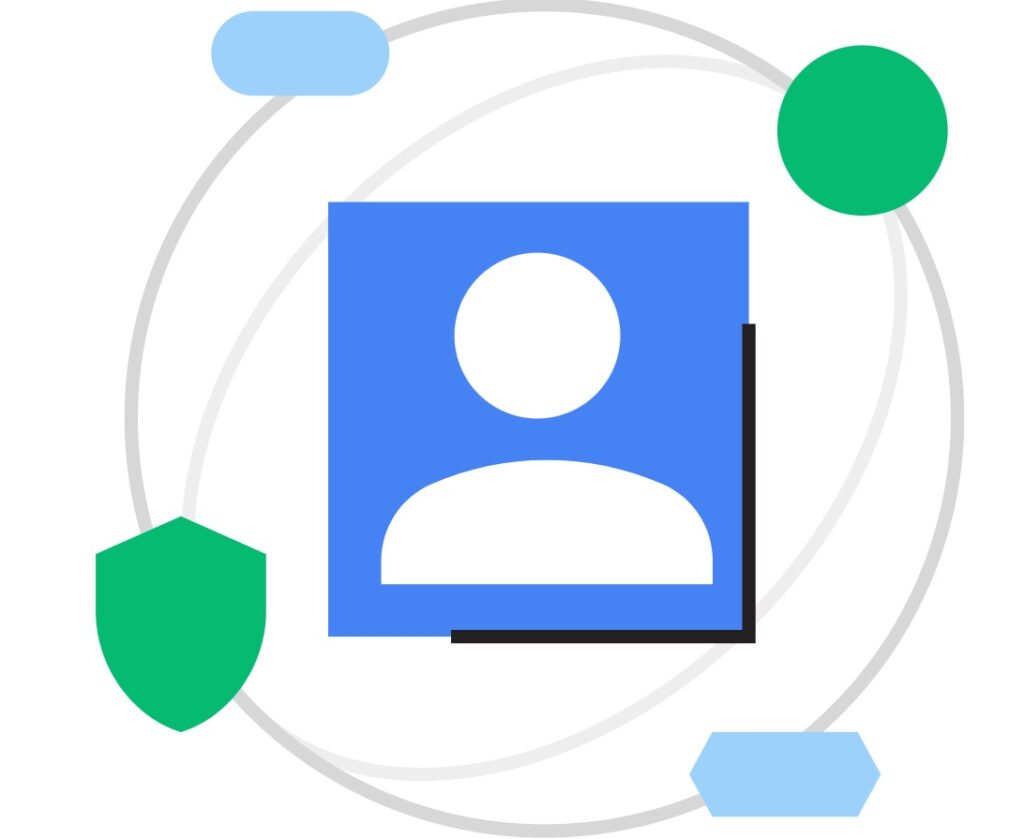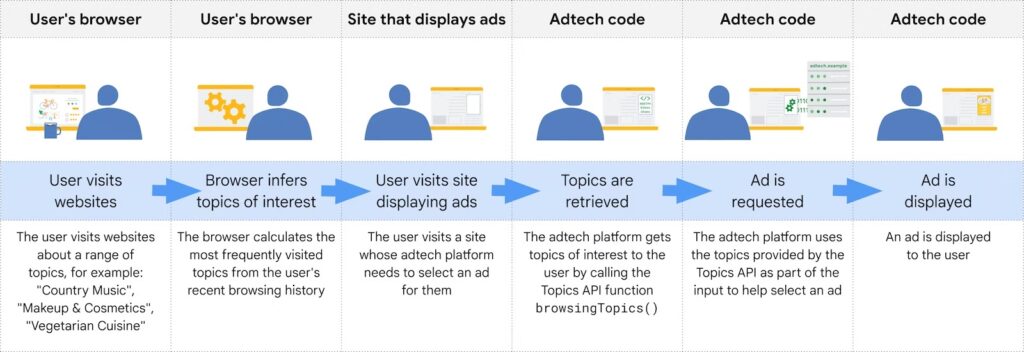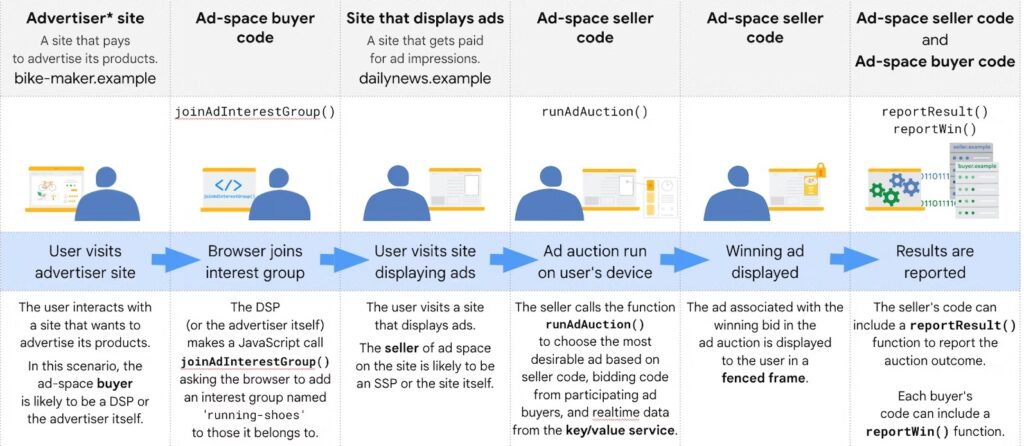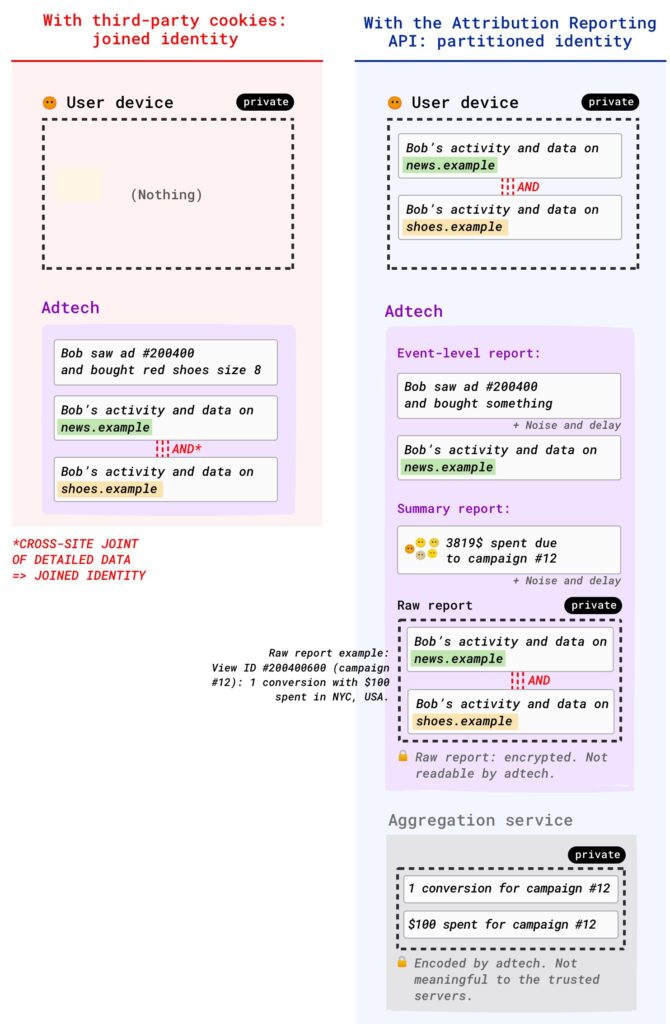
Privacy Sandbox Overview
The Privacy Sandbox is an initiative led by Google that aims to enhance user privacy on the web while still meeting the needs of online advertisers. It involves the development and implementation of new web standards to strike a balance between user privacy and the requirements of personalized online advertising.
Google’s Reliance on Third-Party Cookies:
- Cookie-Based Tracking: Traditionally, online advertising has heavily relied on third-party cookies for tracking user behavior across different websites. These cookies are used to gather information about users’ interests, browsing habits, and preferences, allowing advertisers to deliver targeted ads.
- Privacy Concerns: However, third-party cookies have raised significant privacy concerns. Users often feel that their online activities are being tracked without their consent, leading to a push for increased privacy standards and regulations.
How Chrome Privacy Sandbox is a Win for Users and Advertisers
Google Chrome is revolutionizing web ad targeting by departing from the conventional reliance on third-party cookies for tracking user activity. The Privacy Sandbox proposals ensures, data transmission to adtech companies is no longer necessary, and on-device matching occurs instantly within the user’s device. Google Chrome’s technology ensures that the matching of user interests with ads takes place directly on the user’s device, avoiding the need for centralized storage and matching systems.
This decentralized process minimizes the creation of extensive device and people graphs, emphasizing a shift toward enhanced user privacy. Users utilizing Google Chrome gain insight into the topics associated with their interests, retaining full control with the ability to manually adjust preferences. This marks a substantial departure from centralized data storage, aligning with Google Chrome’s commitment to prioritizing user privacy in the realm of ad targeting.
Privacy SandBox APIs
Ads, Retargeting and Relevant content
Google’s initial solution for interest-based targeting, FLoC (Federated Learning of Cohorts), faced challenges such as user transparency issues and security risks, leading to its replacement by Topics API. Announced on January 25, Topics API aims to enhance interest-based advertising while addressing the shortcomings of FLoC based on feedback and insights gained during trials.
Topics API, part of the Privacy Sandbox, prioritizes user privacy while delivering relevant content and ads. Unlike FLoC, Topics doesn’t share specific visited sites across the web. The API categorizes websites into recognizable topics and identifies the most frequent topics associated with a user’s browsing history. One new topic per week is then shared with visited sites to facilitate advertisers in displaying more relevant ads without revealing specific visited sites.
The browser employs a limited set of topics from a publicly visible list, currently comprising around 469 topics, chosen to reduce the risk of fingerprinting. Notably, sensitive categories such as race, sexual orientation, and religion are excluded. Users have visibility into these topics and the option to remove or disable them entirely through Google Chrome Settings, providing increased control over their ad targeting preferences. Topics API emerges as a refined solution, emphasizing user privacy and relevance in interest-based advertising.

The Protected Audience API, part of the Privacy Sandbox technology, introduces on-device ad auctions, addressing remarketing without relying on cross-site third-party tracking. This innovation enables advertisers to inform users’ browsers about their interest in showing future ads, allowing direct sharing of ad information and bid amounts without compromising user privacy. As users navigate the web, an algorithm in their browser guides relevant ad selections when visiting sites with ad space. Crucially, the Protected Audience API ensures on-device auctions, preventing third-party tracking of user browsing behaviour across sites.
Implemented in Chromium as the first experiment within the TURTLEDOVE family of proposals, the Protected Audience API distinguishes itself by separating the roles of the on-device ad buyer and seller.
Its significance lies in moving towards a web platform where the user’s browser, not advertisers or ad tech platforms, holds information about individual interests. By prioritizing user privacy, the Protected Audience API aims to enable more relevant ads without resorting to cross-site tracking, offering a privacy-conscious solution to the evolving landscape of online advertising.

Digital Ad Measurement
The Attribution Reporting API enables advertisers and ad tech providers to measure conversions in various scenarios, including ad clicks, views, and those within third-party iframes or first-party contexts. It replaces the reliance on third-party cookies in a bid to enhance user privacy and accommodate evolving browser restrictions.
How it Works:
The API functions by linking events on a publisher’s website, such as ad views or clicks, with subsequent conversions on an advertiser’s site. It generates event-level reports by matching clicks or views with conversion data, sending the resulting reports to a predefined endpoint. Additionally, summary reports are created through a process where the browser records events on the user’s device, matches them with conversion data, and produces aggregable reports. These reports, encrypted by the browser, are then sent to an ad tech server, and finally, to an aggregation service for summary report generation.
The Attribution Reporting API offers marketers a privacy-conscious mechanism to gauge ad performance, aligning with the ongoing shift away from third-party cookies. It ensures that summary reports, crucial for insights, are more readily available compared to event-level reports, contributing to the efficiency and effectiveness of attribution measurement.

Google’s Privacy Sandbox marks a significant stride towards a more privacy-conscious web. By redefining the rules of online advertising and introducing innovative APIs, Google is striving to strike a balance between personalized ad targeting and user privacy. As the digital landscape continues to evolve, the Privacy Sandbox stands as a testament to the importance of prioritizing user privacy in the realm of online advertising.











